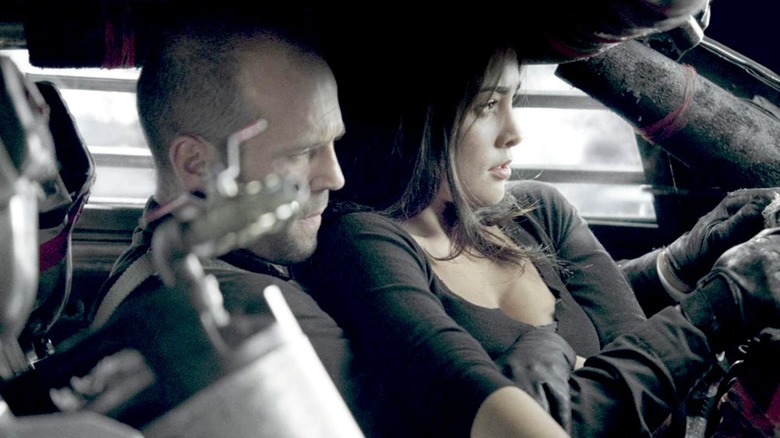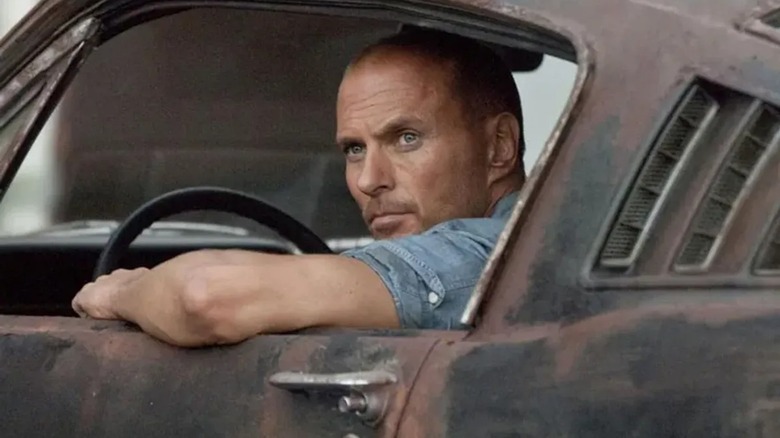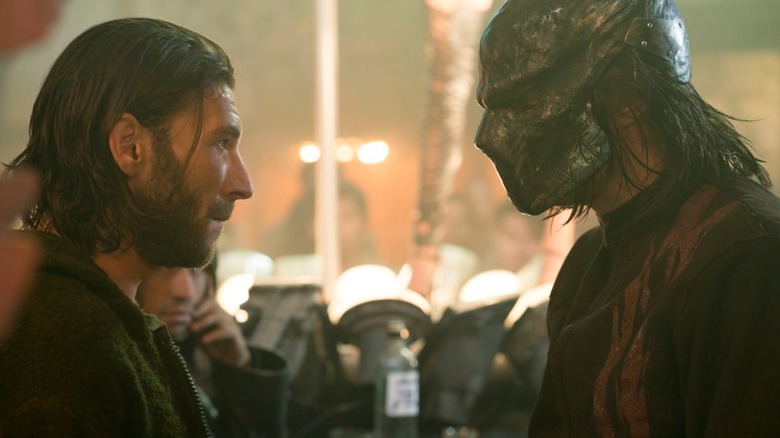The Correct Order To Watch The Death Race Franchise
When the Roger Corman-produced "Death Race 2000" was released in 1975, the film earned a poor critical reception. Major criticisms included a lack of depth in terms of its themes of anarchy and rebellion, with its campy entertainment factor not being enough to offset its overt sleaziness. However, just like every film that's gone on to attain cult status, "Death Race 2000" underwent critical reappraisal over the years and is now deemed a cult classic — one whose indulgent and excessive violence has emerged as one of its strengths.
A sequel to "Death Race 2000," titled "Death Race 2050," wasn't made until 2017. However, there's more: Paul W. S. Anderson's 2008 reboot of Corman's original — the confusingly titled "Death Race" — is also meant to be a prequel. The film traces the crash of the U.S. economy and the rapid rise in crime rates, which birth the titular gladiator-style closed-track race that inmates participate in to attain freedom. Even though Anderson situates the events of "Death Race" before that of "Death Race 2000," the two titles and their connected worlds are treated as two different cinematic universes, making the franchise watch order a bit tricky to figure out.
You can always walk down the time-tested path of watching all the "Death Race" films in the order of release, but this might cause some confusion regarding the chronological progression of events (if you care about that sort of thing at all). The remakes (we have four so far) retain the gritty excess of the original but introduce a more heightened brand of ridiculous action that is best enjoyed without any expectations of coherent storytelling or meaningful immersion. So buckle up, take your thinking cap off, and immerse yourself in the wildly unpredictable world of "Death Race."
The only correct order to watch the Death Race films
Let's get the no-nonsense chronology of the Corman films out of the way first, with "Death Race 2000" and "Death Race 2050" serving as the dual portals to this sadistic, ultra-violent world. Start with the 1975 original, which uses tonal subversion to its advantage to weave a brash, on-the-nose satire about the gamification of basic human rights (à la "Battle Royale"). The whole point is to run over different groups of people to reach the highest score, which leads to a mechanic being manipulated by resistance groups eager to put a stop to such a barbaric sport. The film's stacked cast belts out the most hammed-up performances, including the always-entertaining Sylvester Stallone and David Carradine, whose characters fiercely compete with one another for the title of champion.
The singular absurdism of "Death Race 2000" bleeds into its sequel "Death Race 2050," which is set during a time in which human society is on the verge of complete and utter collapse. The only worthwhile distraction when faced with imminent extinction is — you guessed it — the Death Race, which now utilizes the increasingly dystopian marvels of virtual reality to elevate the race to its extremities. Although this sequel boasts some memorable moments, they are not as head-scratchinglu inspired as its predecessor.
Once you're done, hop over to the remake side of things with 2010's "Death Race 2," which is a prequel to the 2008 reboot. Perhaps the only remake entry that consciously plays to its logic-defying strengths, "Death Race 2" roots itself in the year 3000, a time that is only able to nurture irradiated wastelands that become the racetracks for the death matches held year after year. Between the relentless bloodbath and the thrilling lack of logical consequences, "Death Race 2" never fails to astonish and entertain.
A whole lot of other Death Races
Follow "Death Race 2" up with 2013's "Death Race 3: Inferno," where the titular bloodsport is relocated to South Africa, leaving reigning champion Frankenstein (Luke Goss) no choice but to overcome this final hurdle between him and freedom. "Inferno" does a better job of mapping out a semi-coherent tale with meaningful stakes, which should be followed up with 2008's "Death Race." Anderson's reboot dives into the aftermath of the races being broadcasted as entertainment, where inmates need to overcome outrageous obstacles to walk out free in the end. This provides wrongfully accused convict Jensen Ames (Jason Statham) the impetus to participate as he takes on the moniker of Frankenstein to etch a fresh legacy of blood, guts, and ruthlessness.
We're almost at the end of the finish line. Dive straight into 2018's "Death Race: Beyond Anarchy," which attempts to steer away from the established formula of the remake titles by de-legitimizing the very concept of Death Races ... though not before long-time champion holder Frankenstein is taken down once and for all. Connor Gibson (Zach McGowan) is appointed to accomplish this seemingly impossible task and he retreads the violent path taken by those who came before him, choosing to not alter history despite being encouraged to do so at every turn.
And we're done! In case you're still craving more "Death Race" for some reason, be sure to check out the comic book "Death Race 2020," written and illustrated by Pat Mills and Kevin O'Neill, respectively. Although the comic series was eventually canceled, it helps fill in the blanks about the legendary Frankenstein and introduces some intriguing racers who blaze their own trails in an attempt to reshape and rewrite history.


